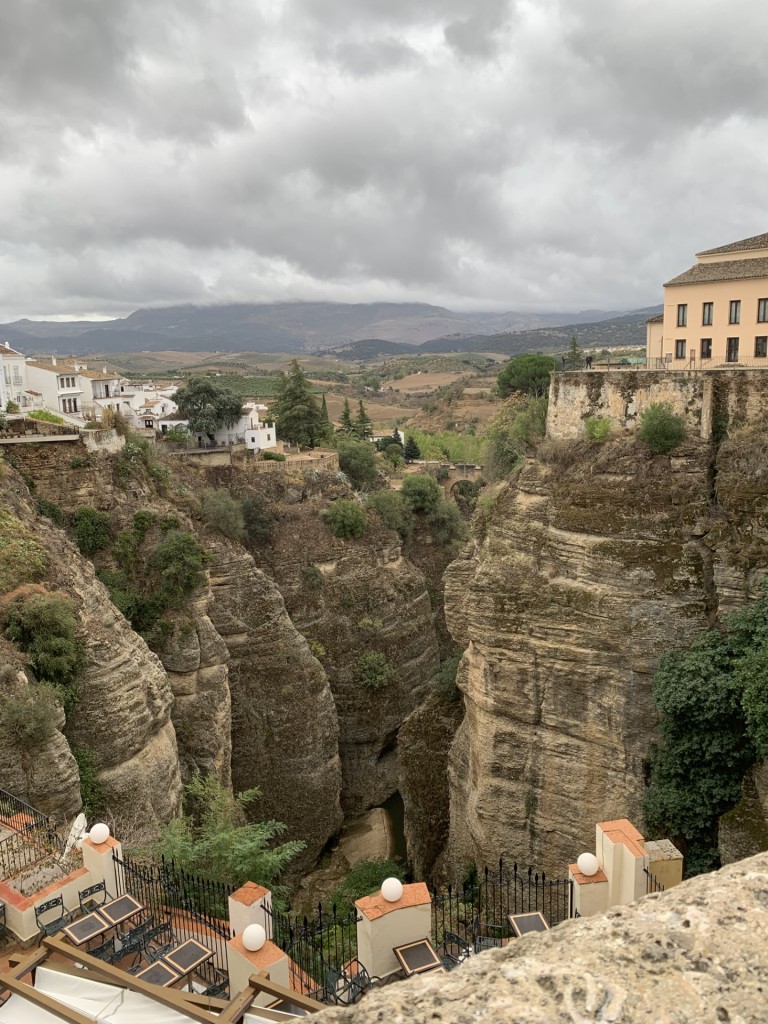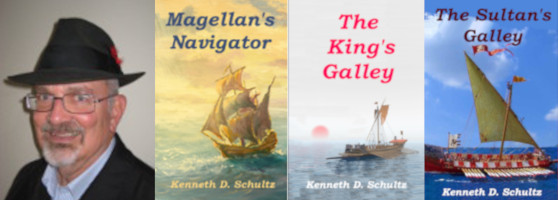
We left Marbella for Granada, but went there by a round-about-route. The road climbed into the foothills through a Spanish national park until finally the picturesque city of Ronda came into view. It’s an ancient town inconveniently split by an over hundred-yard-deep river canyon. Looking into the canyon, I would swear it is deeper. See the picture above. Conveniently, three bridges span the canyon, connecting the two sides of Ronda. One, the Roman Bridge, was first built in Roman times. I would like to have been there to see how they did it.
Like Granada, where we would finish the day, Ronda has strong literary connections. It, and its bullfighting ring, was a favorite place for Ernest Hemingway to summer, as well as later Orson Welles and earlier the renowned German poet Rainier Maria Rilke. Our tour guide hopes, if she hits the lottery, to live in Ronda someday. We toured the bullfighting museum and followed that with a walking tour of town and a visit to a residence perched on the canyon’s edge. It was spectacular.
By late afternoon we descended into the southern Spanish city of Granada. It sits in a fertile basin in the foothills of Spain’s Sierra Nevada Mountains. Like most cities in Iberia, it was settled in Roman times, if not before. Granada fell to Ferdinand and Isabella in 1492, the last Moorish kingdom to do so. The emir surrendered peacefully. His terms included that Moslems in Granada could continue to their faith. This promise was broken eight years later, contributing to the bitter Christian versus Moslem strife that is a backdrop to The King’s Galley.
The night of our arrival in Granada was my only bad meal in Spain, an oversalted mush of a paella. I know paella. I can make a decent one and I’ve eaten a paella made by a native Spaniard. This paella was a travesty.
Today Granada is a modern city, albeit with historic districts. I believe lush, verdant farms once filled the landscape instead of the present apartment buildings. However, as it has for over five hundred years, the Alhambra sits on a hilltop dominating the city.
Isabella and Ferdinand were taken in by the beauty of Granada and the Alhambra. Previously they’d prepared their final resting place in the holy town of Toledo, but having seen the grandeur and magnificence of Alhambra they determined to be interred there. Which is where their remains rest today in the Royal Chapel of Granada next to the Cathedral of Granada in the center of the old town.
What is the Alhambra? It’s one of the most visited sites in Spain. Walls surround thirty-five acres that include a Moorish fortress, the Palace of King Charles V, extensive gardens, and, in my opinion, the crown jewels, the three Nasrid Palaces built by the Moors. I won’t detail these as I don’t have enough room to do them justice. I urge you to read about it elsewhere.
The Alhambra’s more recent past, that is to say the last two-hundred and fifty years, is interesting. The French occupied the Alhambra during the Napoleonic wars in Spain. Like elsewhere in Spain and Portugal, they looted everything that was moveable and, in the case of the Alhambra, blew up part of it when forced to retreat back to France. The Duke of Wellington’s victory at the Battle of Vitoria, the battle that finally booted the French out of Spain, was due in part by the French being slowed by an immense wagon train of pilfered loot. Then followed sad times for the Alhambra, with it falling into disrepair.
Its resurrection is due in part to writers and poets of the Romantic Movement. Lord Byron wrote a poem about it. Washington Irving wrote a popular book, Tales of Granada, after a three-month residence in the Alhambra. (We saw what is now called the Washington Irving room.) This book, along with his other books about Spain, did much to publicize this treasure.
Today Washington Irving is mostly known for his short story The Legend of Sleepy Hollow and its headless horseman. However, Irving was one of the most prolific and famous American authors of his day as well as a diplomat, including ambassador to Spain.
It was about this time that the Spanish began a multi-decade effort to preserve and restore the Alhambra. I thank them for their efforts. Having done a morning tour of the Alhambra, we had a delightful lunch on the balcony of the Alhambra Palace Hotel. Our table gave us a panoramic view of the city. For entertainment that evening we enjoyed a rousing flamenco dance and music display.
